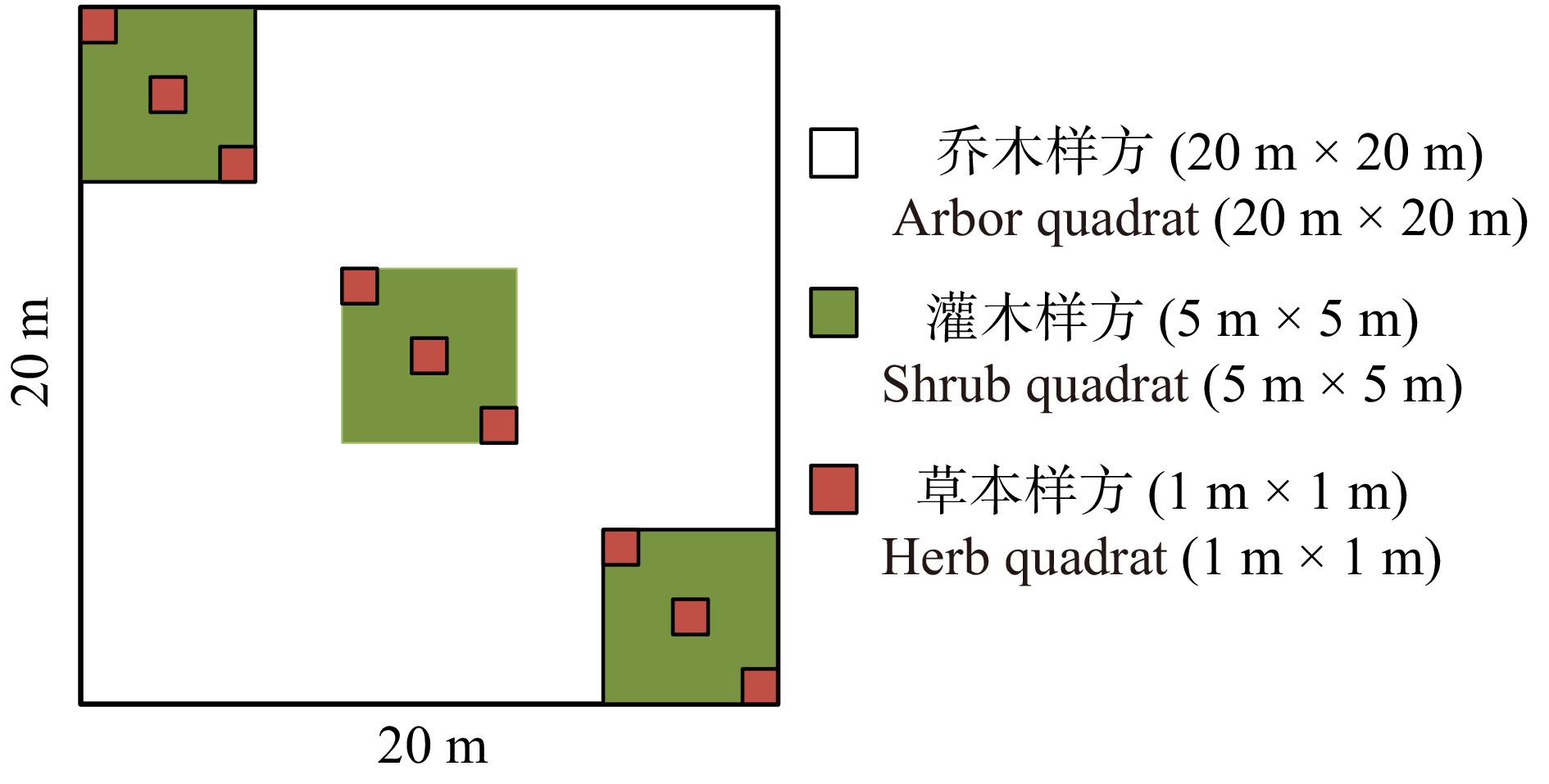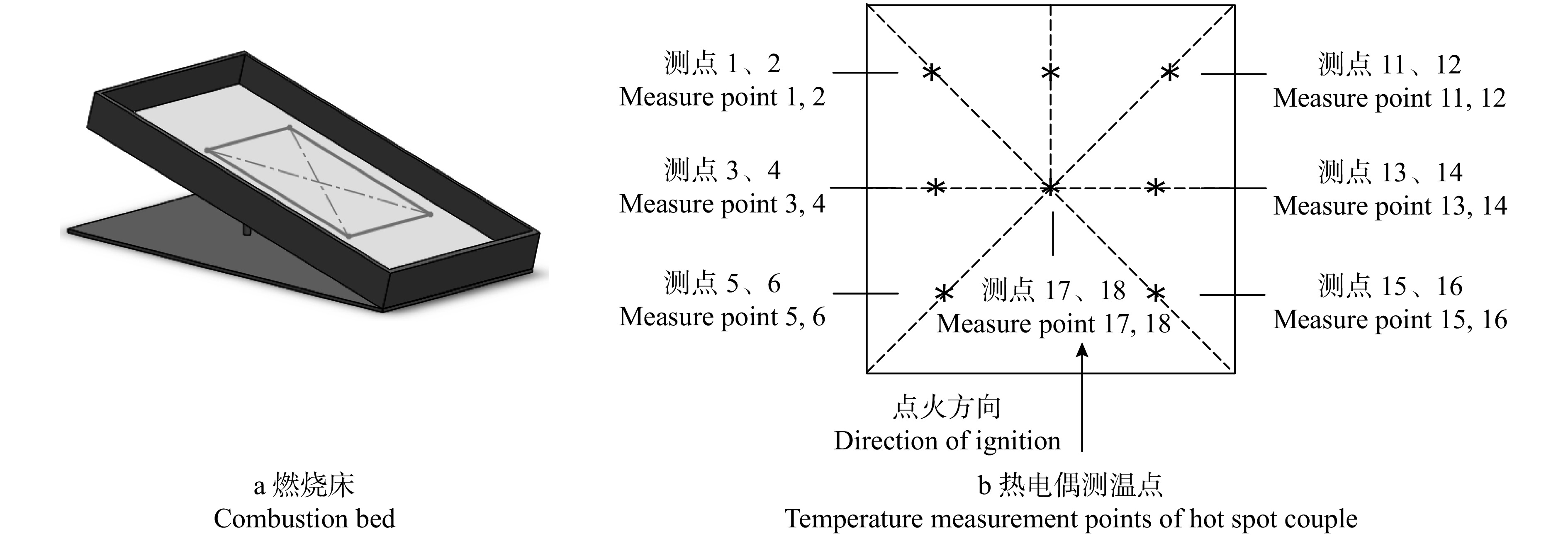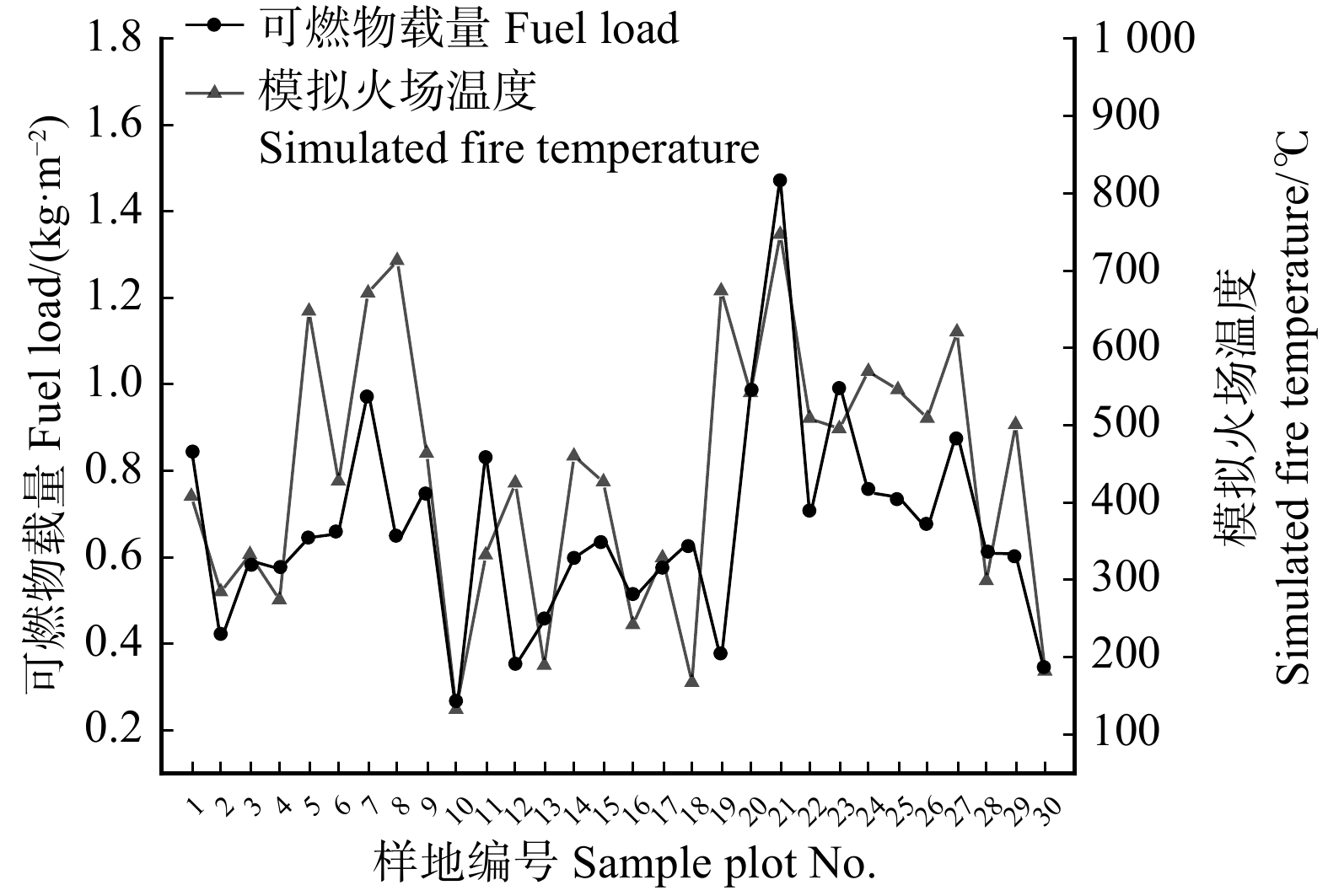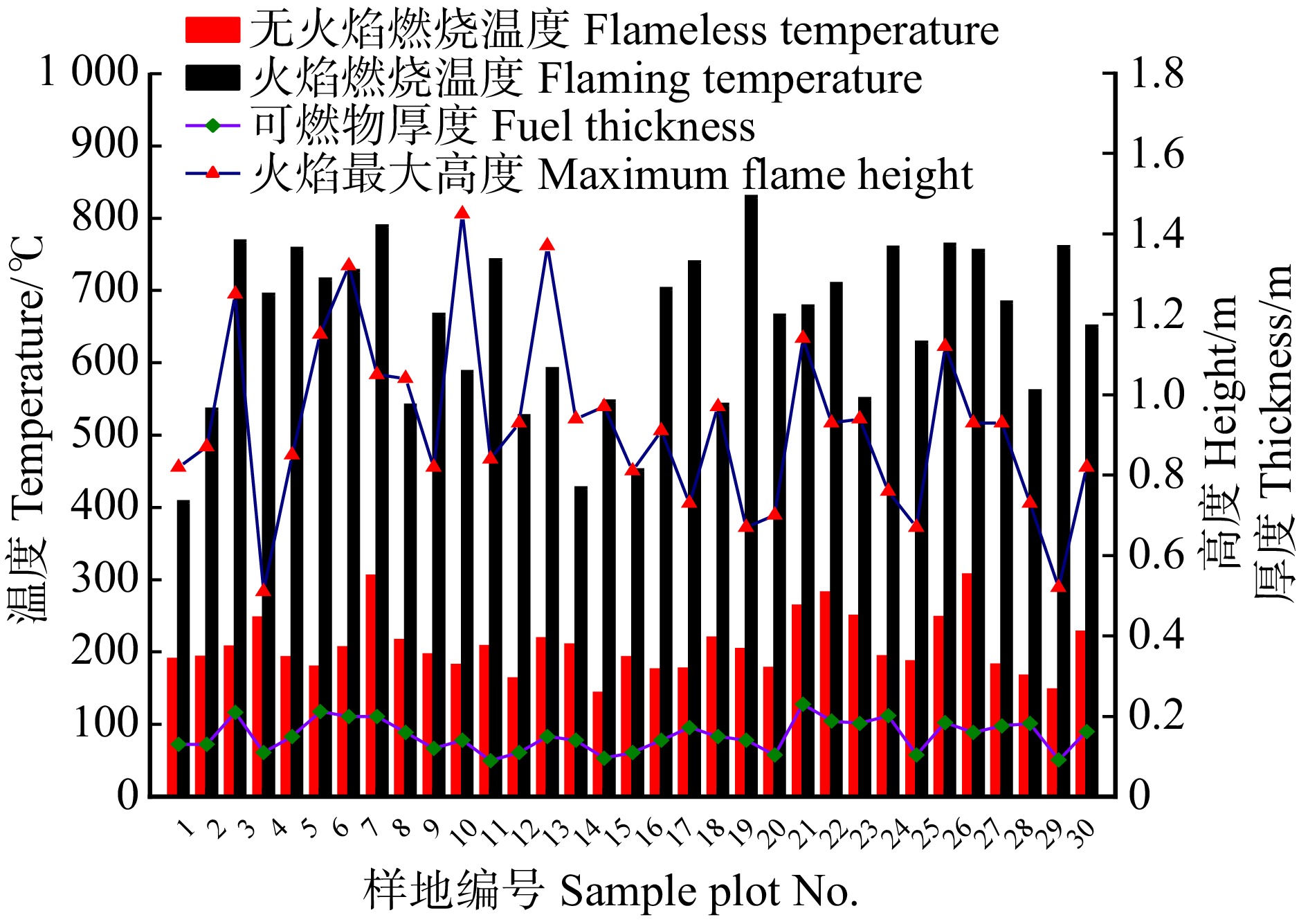Effects of prescribed burning on fire behavior of surface fuel in Pinus yunnanensis forest land
-
摘要:目的 明确周期性(烧除周期为1年)计划烧除条件下云南松纯林地表可燃物状态,以及这类可燃物相应的火行为特征,探究计划烧除对云南松地表可燃物火行为的影响,为合理评估计划烧除的生态意义以及林火管理与扑救提供科学依据。方法 运用野外调查采样与实验室模拟燃烧法,并结合SPSS 23.0软件,对数据进行处理与分析,探究云南省新平县照壁山云南松纯林样地内,计划烧除林分下的可燃物种类、载量、含水率等特征对室内模拟火场温度、火焰高度、热辐射、蔓延速率、烧除率、火强度等火行为的影响。结果 (1)云南松纯林地表可燃物主要是凋落的松针,外加少量枯落的松枝和球果以及枯死的蕨类,种类较单一且林下可燃物大多为细小可燃物。(2)2018—2020年间,云南松纯林林下地表枯死可燃物含水率的平均值分别为9.39%、8.04%、9.89%,平均载量分别为(0.937 ± 0.303) kg/m2、(0.926 ± 0.253) kg/m2、(0.669 ± 0.248) kg/m2。(3)实验室内模拟火行为包括:火强度为(245.95 ± 130.51) kW/m,火焰高度(0.92 ± 0.22) m,火场温度达(437.5 ± 171.6) ℃,热辐射(6.3 ± 0.9) kW/m2,蔓延速率为(1.1 ± 0.3) m/min,可燃物点着时间为1 s,烧除率为62%左右。(4)自然状态下的云南松的死亡率约为1.33%,在2018、2020年外业调查时,计划烧除下的云南松死亡率分别为0.93%、1.27%,云南松具有一定的抗火性和耐火性。结论 (1)周期性计划烧除下的云南松纯林:林分郁闭度较大,林下易燃植被较少,以松针凋落物和草类为主。(2)计划烧除可有效减少地表可燃物负荷量,地表可燃物的平均载量不到1 kg/m2。防火期内,云南松林地表枯死可燃物的含水率低于10%,极易被引燃,但火焰高度在0.5 ~ 1.5 m范围内,火强度不高于750 kW/m,属于低强度地表火;火场温度高,热辐射强,火蔓延速度一般,火场可人工控制;实验室模拟烧除率高,燃烧效果好。(3)在易火生境以及对火有一定适应性的林分中,开展周期性计划烧除必要且可行。Abstract:Objective This paper aims to clarify the status of surface fuel and corresponding fire behavior characteristics of pure Pinus yunnanensis stand under the conditions of periodic (burning cycle was 1 year) prescribed burning, and then explore the impact of prescribed burning on the fire behavior of surface fuel of P. yunnanensis, and reasonably evaluate the ecological significance of prescribed burning, so as to provide scientific basis for forest fire management and fighting.Method Sampling in field investigation and simulating combustion in laboratory, using the SPSS23.0 to process and analyze the data, we explored the influence of fuel types, fuel loads, moisture content and other characteristics of prescribed burning on fire behavior such as the temperature of fire, flame height, thermal radiation, spread rate, burning rate, fire intensity, etc. in Zhaobi Mountain, Xinping County, Yuxi City, Yunnan Province of southwestern China.Result (1) The main fuel on the surface of pure P. yunnanensis stand was the withered pine needles, plus a small amount of withered pine branches and cones and dead ferns, the species was relatively single, and most of the fuel under the forest was fine fuel. (2) From 2018 to 2020, the average moisture content of dead fuel under the pure forest of P. yunnanensis was 9.39%, 8.04% and 9.89%, and the average fuel loads were (0.937 ± 0.303) kg/m2, (0.926 ± 0.253) kg/m2 and (0.669 ± 0.248) kg/m2, respectively. (3) The simulated fire behavior in the laboratory included: the fire intensity was (245.95 ± 130.51) kW/m, the flame height was (0.92 ± 0.22) m, fire ground temperature was (437.5 ± 171.6) ℃, the thermal radiation was (6.3 ± 0.9) kW/m2, the spread rate was (1.1 ± 0.3) m/min, the ignition time of the surface fuel was 1 s and burning rate was about 62%. (4) The mortality of P. yunnanensis in natural state was about 1.33%. In the field survey in 2018 and 2020, the mortality of P. yunnanensis under prescribed burning was 0.93% and 1.27%, respectively. P. yunnanensis has certain fire resistance.Conclusion (1) For the pure P. yunnanensis stand under periodic prescribed burning, the canopy density of the standing forest is large, and the combustible vegetation under the forest is less, mainly pine needle litter and grass. (2) Prescribed burning can effectively reduce the surface fuel load, and the average load of surface fuel is less than 1 kg/m2. During the fire prevention period, the moisture content of the dead fuel on the surface of P. yunnanensis forest is less than 10%, which is easy to be ignited, but the flame height is within the range of 0.5−1.5 m, and the fire intensity is less than 750 kW/m, which belongs to low intensity fire; the temperature of the fire ground is high, the thermal radiation is strong, the fire spread speed is general, and the fire field can be controlled; the simulated burning rate in the laboratory is high, and the combustion effect is good. (3) It is necessary and feasible to carry out periodic prescribed burning in fire prone habitats and forests with certain adaptability to fire.
-
Keywords:
- surface fuel /
- fire intensity /
- fire behavior /
- prescribed burning /
-
pure Pinus yunnanensis stand
-
树冠是衡量树木生长发育的重要指标,其结构深受自身遗传因素、年龄、林分密度、物种组成、立地条件以及施肥和间伐等森林经营管理措施相互作用、反馈调节的综合影响[1]。枝条作为树冠的基本骨架,它的大小、分布、数量和存活状态及其空间排列可以用来模拟树冠形状、反映林木之间的竞争、衡量林木在枯损中的生命力等[2-3]。此外,枝条影响光的入射和降水的截留,控制着叶面积的大小和木材的恢复潜力,为一些野生动物提供了重要的生活环境[4-5]。
现阶段人工幼中龄林在我国森林资源体系中占据主导位置,这些林分密度较大,易受病虫害爆发的影响,其林下生物多样性、森林稳定性和生态服务功能较低。而抚育间伐是目前森林经营实践中调节林分结构最有效的方法,其有助于增强林分抵御疾病和抗自然干扰能力,提高林分产量和质量[6]。为此,很多学者[7-11]利用分布函数和生物数学模型模拟不同抚育间伐强度对人工纯林中林木胸径、树高、材积和生物量等属性的影响,认为中、强度间伐可以显著提高林分平均单株直径生长量、立木材积、单株立木生物量。但以上研究都没有考虑抚育间伐对林冠生长、林下光环境、物种多样性以及进界木生长发育的影响,因此,部分学者[12-14]利用随机区组试验和生物数学模型对抚育间伐后林下物种多样性、土壤等因子进行了对比分析,发现弱度间伐并没有显著改变林下植物种类组成、灌草生物量和土壤物理性质,但改善了林下光环境,显著提高了林下进界木树高的生长。以上研究均在侧重分析抚育间伐对林分结构的影响,忽略了对林木树冠及枝条的影响。为此,Ishii和McDowell[15]首次提出枝条密度这一概念,并对不同林龄的花旗松(Pseudotsuga menziesii)枝条密度进行了模拟,发现枝条密度与树冠高度存在指数型关系。随后,Weiskittel[16]等基于前者改进的方法,利用混合模型分析了5种针叶树种之间枝条密度的变化规律,表明了种属差异对树冠结构特征变化有显著影响;Hein[17-18]等也同样采用混合模型的方法在特定的林分条件下对挪威云杉(Picea abies)和花旗松的轮枝数量进行了系统性的分析;我国学者郭孝玉[19]首次发现长白落叶松(Larix olgensis)人工林枝条密度空间分布格局呈塔形和倒“J”形,苗铮[20]和王曼霖[21]利用Possion回归分析了树木枝条数量的总体变化趋势。但他们并没有阐明枝条数量与林分经营措施之间的关系,Weiskittel[22]虽然通过模型研究了不同植被竞争、树叶病虫害管理、林分间伐及施肥管理对树冠结构的影响,但其并没有将抚育间伐效应引入到模型中,所建模型不能准确描述间伐对林木枝条的影响。
本研究基于黑龙江省林口林业局和东京城林业局不同林分条件及抚育间伐强度下的49棵人工红松(Pinus koraiensis)的树干解析和枝解析数据,以枝条密度为因变量,考虑林分抚育间伐效应,构建单水平非线性混合效应模型,旨在揭示红松人工林枝条数量与林分条件、树木大小及林分抚育间伐之间的关系,为合理控制林分密度、构建生长与收获模型以及森林经营管理措施提供理论依据。
1. 研究区概况与研究方法
1.1 研究区概况
林口林业局地处黑龙江省牡丹江市东北部,施业区跨林口、勃利和海林三县市,地理坐标为129°41′50″ ~ 130°34′20″E、45°03′29″ ~ 45°58′30″N,属于中温带大陆性季风气候。该地区海拔范围为122 ~ 1 184 m,林区年平均气温2.7 ℃,最高气温可超37 ℃,最低气温可达−39 ℃,年平均降水量580 mm。全局施业区经营总面积为273 025 hm2,森林覆盖率为80.47%,林区地势多以低山丘陵为主,植被类型主要以天然次生林、针阔混交林以及阔叶混交林为主。
东京城林业局地处黑龙江省宁安市西南部,施业区处牡丹江中上游,张广才岭东南部,全国最大的高山堰塞湖镜泊湖镶嵌在该林区内。地理坐标为128°07′45″ ~ 130°02′35″E、43°30′30″ ~ 44°18′45″N,属于中温带大陆性季风气候。该地区海拔范围为260 ~ 1 559 m,林区年平均气温3 ℃,年平均降水量550 ~ 600 mm。全局施业区经营总面积为418 468 hm2,森林覆盖率为87.55%,其中天然林蓄积占有林地蓄积的88.79%,而人工林仅为11. 21%[23]。各采样点的位置如图1所示。
1.2 数据收集与整理
为揭示抚育间伐与红松人工林枝条属性的关系,结合研究区域红松人工林资源现状,于2016年在林口林业局和东京城林业局不同立地条件(地位指数为9.15 ~ 16.19 m)、不同年龄(31 ~ 38年)的红松人工林林分中设置了29块红松人工林标准地,每块标准地面积为0.06 hm2(20 m × 30 m)。所有林分在2008年进行了第一次透光抚育,抚育间伐方式为上层透光,伐除林分上层非目的树种,以及病腐木和枯立木,同时保留具有稳定林分、生态价值明显、有培育前途的健康林木。根据其株数抚育强度设置4种作业区:(1)对照(CK),不间伐或仅作轻度卫生伐;(2)弱度间伐(L),抚育株数强度为10% ~ 20%;(3)中度间伐(M),抚育株数强度为20% ~ 30%;(4)强度间伐(H),抚育株数强度为30% ~ 40%。由于对所设置的作业区伐去部分小径阶及生长不良林木,因此,抚育蓄积强度在10% ~ 20%左右。基于各样地的年龄和优势木平均高数据,采用Logistic方程、Mitscherlich方程、Korf方程和Richards方程分别进行拟合,通过均方根误差(RMSE)和相关系数(R2)以及参数的有效性,最终确定采用Richards方程作为红松人工林的地位指数导向曲线。差分后可得计算公式如下:
SI=HT(1−e−bA0)c(1−e−bA)c (1) 式中:SI为地位指数,HT为优势木树高,A0为红松人工林的基准年龄(黑龙江地区红松人工林的基准年龄为40年),A为林分年龄,b和c为方程参数。红松人工林抚育间伐因子及林分调查因子统计量详见表1。
表 1 红松人工林抚育间伐因子及林分因子统计表Table 1. Statistics of thinning and stand factors for Pinus koraiensis planation统计量
Statistic间伐强度
Thinning intensity
(TI)/%间伐年龄/a
Thinning age
(TA)/year地位指数
Site index
(SI)/m林分平均胸径
Average stand
DBH/cm林分平均高
Mean stand
height/m林分断面积/(m2∙hm−2)
Stand basal area/
(m2∙ha−1)林分密度/(株∙hm−2)
Stand density/
(tree∙ha−1)最大值 Max. value 40.00 35.00 16.19 18.76 11.85 33.62 2 217 最小值 Min. value 0.00 28.00 9.15 11.62 6.90 12.55 716 平均值 Mean value 22.62 31.52 13.35 14.76 9.78 23.12 1 388 标准差 SD 13.26 1.53 1.65 1.83 1.31 5.27 371 变异系数 CV/% 58.64 4.84 12.38 12.40 13.37 22.79 26.72 2019年7月,分别测定29块样地中样木的胸径、树高、第一活枝高和冠幅等林木因子。根据每木检尺结果,计算各标准地平均胸径,采用等断面积径级标准木法将林木划分为五级。在不同立地条件不同抚育强度的样地中选择平均木,并在林口林业局西北楞经营所的8块样地中补充了一、三、五级不同大小的样木作为标准木,共计选取49株解析标准木。对所选标准木进行树干解析和枝条解析。由于本研究只讨论一级活枝数量与抚育间伐之间的关系,因而采用树干主轴切割分层法测定一级枝条的总着枝深度(DINC)、枝长(BL)、弦长(BCL)、基径(BD)、着枝角度(θ)等枝条属性因子,并注明存活状态。枝条密度一定程度上反映了树干分枝特征,因此,基于Ishii等[15]改进的方法,按照总着枝深度将树干从梢头到树冠基部第一活枝高处以1 m为基准划分为若干冠层,并统计每1 m区分段一级活枝的数量,即为枝条密度。本研究共获得49株红松解析木和4 370个一级枝条数据,将49 株解析木按分层抽样分为建模数据(40株,3 534个枝条)和检验数据(9株,836个枝条),红松人工林解析木的林木测定因子及枝条密度统计量信息详见表2。
表 2 红松人工林解析木和枝条分布统计表Table 2. Statistics of sample trees and branch distribution for Pinus koraiensis planation项目
Item统计量
Statistic年龄/a
Age/year胸径
DBH/cm树高
Tree height
(HT)/m冠长
Crown length
(CL)/m冠幅
Crown width
(CW)/m冠长率
Crown length
ratio (CR)枝条密度/(个∙m−1)
Branch density/
(number∙m−1)拟合数据
(样本容量 = 40)
Fitting data
(sample size = 40)最大值 Max. value 38 23.60 14.23 10.60 2.93 0.88 29 最小值 Min. value 31 8.00 7.05 4.30 1.13 0.48 1 平均值 Mean value 35.15 14.79 10.42 6.96 1.97 0.68 13.98 标准差 SD 1.53 4.60 1.79 1.34 0.45 0.11 5.20 变异系数 CV/% 4.35 31.09 17.17 19.24 22.80 16.40 37.23 检验数据
(样本容量 = 9)
Validation data
(sample size = 9)最大值 Max. value 37 25.50 13.37 8.69 3.13 0.82 31 最小值 Min. value 33 8.00 7.90 3.80 1.13 0.48 3 平均值 Mean value 34.96 16.09 10.84 7.69 2.22 0.71 14.17 标准差 SD 1.18 4.94 1.48 1.43 0.63 0.11 5.70 变异系数 CV/% 3.38 30.67 13.67 18.55 28.48 15.21 40.21 1.3 研究方法
1.3.1 冠层枝条数量方差分析
数据经Excel 2016整理后,利用R软件对不同间伐强度(TI)、不同地位指数(SI)的林木枝条数量进行描述统计和方差同质性检验,主要选取5个反映枝条数量的指标(总活枝数量、平均枝条密度、最大活枝密度、最大活枝密度的冠层深度、最大活枝密度相对冠层深度)。并采用双因素方差分析研究不同TI和SI对树冠枝条数量的垂直分布的影响。采用LSD法进行差异显著性检验,显著性水平设定为α = 0.05。
1.3.2 枝条密度基础模型
通过分析数据初步发现,冠层上部枝条发生死亡的几率较低,且受抚育间伐因子引起的枝条密度增长速率相对恒定。因此,本文基于Ishii和McDowell[15]改进的方法,即将树高按1 m分层,统计各冠层内一级活枝的数量,枝条密度(个/m)的计算公式为:
ρNB=NBjDHCj (2) 式中:
j 为某一冠层高度位置等级(0,1,2,⋯,n ),NBj 为第j 个冠层内的枝条数量,DHCj 为第j 个冠层的长度(本文中DHC为1 m)。基于(1)式,建立人工红松枝条密度的一般非线性回归模型(基础模型)时,将枝条密度由上冠到下冠的垂直变化模拟为负指数过程,基本形式如下:
ρNB=λexp(−kDINC) (3) 式中:
ρNB 为枝条密度,DINC 为总着枝深度(各枝条到树梢的距离),λ 、k 均为参数,采用非线性最小二乘法估计。然而,据Andreassen[24]、Weiskittel[1, 16]和Hein[17-18]等对道格拉斯冷杉(Pseudotsuga menziesii)、北美乔松(Pinus strobus)等几个树种枝条生长模型的研究,认为林木枝条数量不仅与着枝深度(DINC)关系密切,还与树木大小(如胸径(DBH)、树高(HT))、竞争因子(如林分前期每公顷断面积(S)、林分前期每公顷株数(N))和林分因子(如地位指数(SI)、林分间伐前期年龄(TA)、抚育间伐强度(TI))等关系显著。因此,本研究采用全部子集法[11]筛选自变量,充分考虑自变量参数检验显著性(P < 0.05),将TI与TA的比值作为一个变量加入基础模型中,以此来量化抚育间伐对因变量(
ρNB )的影响。全部子集法是筛选模型自变量的一种重要方法。它考虑模型中自变量所有可能的组合,根据特定的模型评价指标从中选出表现最优的一组。其优点是可以处理自变量多重共线性(方差膨胀因子(VIF)>10时),但在变量数量较大时(例如自变量个数远远超过10),即使是在应用计算机的情况下,也需要较高的计算量。当自变量个数较少时,该方法可以全面考虑各种情况,因此在研究中受到高度重视。
1.3.3 非线性混合模型
为考虑样地或样地内样木大小对枝条密度的随机干扰,在基础模型之上引入随机效应(即样地效应和样木效应),因此,单水平非线性混合效应模型的形式为[25]:
{yij=f(φijk,νijk)+ξij,φij=Aijχ+Bijβi,βi∼N(0,D),ξij∼N(0,σ2Ri)i=1,⋯,l;j=1,⋯,mi (4) 式中:
yij 表示第i 块样地各1 m区分段上活枝的数量;l 为样地数量;mi 为第i 个样地中连续观测的区分段个数;f 为含有参数向量φij 和预测变量向量νij 的函数;ξij 表示服从正态分布的组内误差;Aij 为(fij×p) 维已知设计矩阵;χ 为(p×1) 维固定参数向量;βi 为第i 块样地带有方差−协方差矩阵D的(q×1) 维随机效应向量;Bij 为随机效应的设计矩阵;σ2 为方差,Ri 为第i 块样地的方差−协方差矩阵;ξij 和βi 相互独立。基于建模数据,本文利用R软件nlme包中nlme()函数,采用极大似然法估计非线性混合效应模型参数。在未知协方差结构时,可将模型中所有参数看成混合效应参数,通过比较拟合统计量再从收敛的模型中选出模拟精度最高的模型。本研究采用的随机效应方差−协方差结构是无结构矩阵(UN)、对角矩阵(UN(1))和复合对称矩阵(CS)。为了进一步验证抚育间伐对枝条密度的影响,在拟合出最优混合模型后,利用其固定效应模拟不同条件下不同大小的人工红松枝条密度分布规律图,以此对比分析枝条密度随各变量变化的的差异。
1.3.4 模型评价与检验
利用独立的建模样本数据进行建模,采用调整决定系数(Ra 2)、赤池信息准则(AIC)、贝叶斯信息准则(BIC)、对数似然值(Log likelilood)等评价指标对模型拟合优度进行评价比较,对参数个数不同的模型进行似然比(LRT)检验,从而选出最优混合模型。在此基础上,为最优模型加入不同的随机效应方差−协方差结构重新拟合,采用Ra 2、均方根误差(RMSE)等评价指标选出最优方差结构。
利用独立的检验样本数据对模型的预估能力进行检验,其统计指标为平均绝对偏差(MAE)、平均相对偏差绝对值(RMAE)、模型预估精度(
Fp )等,混合效应模型检验时固定效应部分的检验与传统的检验方法相同,而随机参数检验需要二次抽样来计算随机参数值,然后计算相应统计指标。模型评价与检验统计指标计算公式如下:
调整决定系数(R2a):R2a=1−(n−1)n∑i=1(yi−ˆyi)2(n−p)n∑i=1(yi−ˉyi)2 (5) 均方根误差(RMSE):RMSE=√n∑i=1(yi−ˆyi)2n−p (6) 平均绝对偏差(MAE):MAE=n∑i=1|yi−ˆyin| (7) 平均相对偏差绝对值(RMAE):RMAE=1nn∑i=1|yi−ˆyiyi|×100% (8) 预估精度(Fp):Fp=(1−t0.05⋅Sˉyˉy)×100% (9) 式中:
yi 为实测值,ˆyi 为预测值,ˉy 为yi 的平均值,Sˉy=√∑(yi−ˆyi)2n(n−p) ,n为样本数,p为模型参数的个数。对于混合模型(4),根据经验线性无偏最优预测法(EBLUP)[26],可采用下述公式计算模型检验时的随机效应:
ˆβi=ˆDˆZTi(ˆZiˆDˆZTi+ˆRi)−1[ˉyi−f(Aˆχi,vi)] (10) 式中:
ˆβi 预测的随机效应参数,ˆD 、ˆRi 分别为随机效应参数和误差项协方差矩阵的估计,ˆZi 为混合模型(3)中因变量对各随机效应参数的偏导数组成的矩阵,ˉyi 为检验样本中第i 个样地(或样木)活枝数量的平均值,ˆχi 为模型固定效应参数的估计值,vi 为第i 个样地(或样木)中预测变量组成的矩阵。2. 结果与分析
2.1 枝条密度方差分析
通过对抚育间伐后林木的枝条数量进行间伐强度和地位指数的统计假设检验,在α = 0.05水平下,发现间伐强度、地位指数及其交互作用对枝条数量存在一定的影响,遂采用LSD法在所有的TI-SI组合间进行多重比较。双因素方差分析结果表明(表3):不同林分的林木枝条密度之间存在显著差异,其中总活枝数量在不同间伐强度、不同地位指数间有显著差异,平均活枝密度只有当间伐强度为M时不同地位指数间有显著差异,而最大活枝密度的冠层深度和最大活枝密度的相对冠层深度在间伐强度为CK和L时不同地位指数之间有显著差异,在M和H时无显著差异。在间伐强度和地位指数影响的基础上,总活枝数量和最大活枝密度的冠层深度对其交互作用也有显著响应。这可能与林分郁闭度和抚育措施有很大关系,红松人工林在幼龄阶段生长旺盛,产生了大量的嫩枝嫩芽,当林分达到郁闭后,林木树冠竞争比较激烈,冠层底部枝条生长受到自身遮阴以及与灌木层之间竞争的影响,导致树冠下层枝条大量枯死,而在此时若进行及时的抚育间伐措施会减缓枝条死亡,从而为保证单株林木生长优势提供营养物质。
表 3 不同间伐强度、不同地位指数枝条密度双因素方差分析Table 3. Two-way ANOVA of different thinning intensities and site index for branch densityTI SI n 总活枝数量
Total number of
living branch平均活枝密度/(个∙m−1)
Average density of
living branch/
(number∙m−1)最大活枝密度/(个∙m−1)
Max. density of
living branch/
(number∙m−1)最大活枝密度的冠层深度
Crown depth of
Max. branch
density/m最大活枝密度相对冠层深度
Relative crown depth of
Max. branch
density/%CK Ⅰ 6 98 ± 33abcd 14.1 ± 1.84ab 19.59 ± 1.87ab 2.76 ± 0.48bc 41.97 ± 11.50b Ⅲ 3 73 ± 21d 12.3 ± 0.63ab 16.09 ± 1.16bc 2.99 ± 0.25abc 55.27 ± 24.59ab V 3 74 ± 7cd 11.61 ± 0.35b 16.21 ± 0.21bc 4.14 ± 0.42a 70.6 ± 2.4a L Ⅲ 4 108 ± 22abc 13.9 ± 0.95ab 23.51 ± 5.64a 3.53 ± 0.79ab 49.25 ± 8.6b Ⅳ 2 72 ± 6d 11.16 ± 0.29b 16.56 ± 3.36bc 1.90 ± 0.06c 33 ± 5.23b V 2 68 ± 1d 11.39 ± 0.19b 17.08 ± 0.8bc 3.46 ± 0.77abc 56.8 ± 14.01ab M Ⅱ 10 112 ± 15ab 14.52 ± 3.06a 19.34 ± 4.1b 3.34 ± 1.04abc 44.95 ± 14.29b Ⅳ 7 97 ± 29abcd 12.03 ± 1.91b 15.9 ± 2.34c 2.99 ± 1.35abc 39.4 ± 14.89b V 2 74 ± 21cd 12.28 ± 3.5ab 17.11 ± 2.43bc 2.64 ± 0.43bc 44.35 ± 6.15b H Ⅰ 2 132 ± 5a 15.5 ± 0.68a 21.51 ± 1.54ab 2.88 ± 0.05abc 34.1 ± 0.42b Ⅱ 4 119 ± 8a 14.97 ± 0.81a 20.15 ± 0.72ab 3.44 ± 0.88abc 48.5 ± 15.41b Ⅲ 4 87 ± 34bcd 13.68 ± 2.99ab 17.44 ± 4.7bc 3.04 ± 0.29abc 50.8 ± 14.28ab 注:n.解析木株数;地位指数等级(SI):Ⅰ (15.03 ~ 16.19 m)、Ⅱ (14.01 ~ 14.81 m)、Ⅲ (13.15 ~ 13.99 m)、Ⅳ (11.94 ~ 12.91 m)、Ⅴ (9.15 ~ 11.09 m)。表中数值为平均值 ± 标准差,同一列数据后不同字母表示5%水平差异显著。Notes: n represents parse tree number; site index level (SI): Ⅰ (15.03−16.19 m), Ⅱ (14.01−14.81 m), Ⅲ (13.15−13.99 m), Ⅳ (11.94−12.91 m), Ⅴ (9.15−11.09 m). The data in table are mean ± SD. Different letters in the same column after data indicate significant differences at 5% level. 2.2 最优基础模型选取
将所有影响枝条密度的单木因子引入基础模型(3),并在方差分析的基础上,引入立地条件(地位指数)及间伐效应(抚育间伐强度、抚育间伐年龄),利用全部子集法(已将VIF > 10的自变量剔除),通过RMSE和Ra 2两个指标筛选对枝条密度有较强影响的变量,结合不同间伐条件下样地中树木枝条密度的分析结果,最终确定含有7个变量(DINC、lnRDINC、RDINC2、DBH、CL、SI、TI/TA)的模型拟合效果最佳,且所有参数均极显著(P < 0.001),其模型表达式为:
ρNB=λexp(−(k1DINC+k2lnRDINC+k3RDINC2+k4DBH+k5CL+k6SI+k7(TI/TA))) (11) 式中:
ρNB 为枝条密度,本文中指红松树干每1 m区分段上一级活枝的数量;DBH为单木胸径,cm;CL为单木冠长(树高与第一活枝高的差值),m;DINC为总着枝深度(各一级枝到树梢的距离),m;RDINC为相对着枝深度(各一级枝总着枝深度与冠长的比值);SI为地位指数,m;TI为林分抚育间伐强度(即抚育株数强度),%;TA为林分抚育间伐年龄;λ 、k1 、k2 、k3 、k4 、k5 、k6 、k7 均为模型预估参数。基于3 534个枝条建模数据的最优基础模型(11)拟合结果详见表4,其模型Ra 2 = 0.591 6,RMSE = 2.990 4。表 4 最优基础模型参数拟合结果Table 4. Fitting results of the best basic model参数 Parameter 样本容量 Sample size 估计值 Estimation 标准误差 SE t P λ 3 534 24.485 517 1.193 713 20.512 1 < 0.000 1 k1 3 534 0.155 000 0.012 954 11.965 6 < 0.000 1 k2 3 534 −0.616 205 0.017 812 −34.595 3 < 0.000 1 k3 3 534 1.279 126 0.062 997 20.304 6 < 0.000 1 k4 3 534 0.005 237 0.001 403 3.733 7 < 0.000 1 k5 3 534 −0.037 561 0.006 627 −5.667 9 < 0.000 1 k6 3 534 −0.048 652 0.003 168 −15.660 0 < 0.000 1 k7 3 534 −0.055 832 0.005 951 −9.381 7 < 0.000 1 2.3 枝条密度非线性混合模型的建立
2.3.1 枝条密度非线性混合模型拟合结果
基于最优基础模型(11),随机效应方差−协方差结构为UN时,利用R 3.6.1软件nlme包对式(11)的不同随机效应参数组合进行拟合,采用Ra 2、Log-likelihood、AIC、BIC对不同模型的拟合优度进行比较,此外,为避免过参数化问题,对不同模型进行似然比检验LRT,其中P < 0.05代表差异显著,拟合结果详见表5(本研究中仅列出相同随机效应参数个数情况中的最优模型)。
表 5 基于不同随机效应参数组合的枝条密度模型拟合精度比较Table 5. Comparison of mixed branch density model based on different random effect parameters随机效应
Random effect模型
Model随机效应参数
Random effect
parameter参数个数
Number of
parameterRa 2 AIC BIC Log-
likelihood似然比检验
Likelihood ratio
test (LRT)P 11 无 None 8 0.591 6 18 533.29 18 588.82 −9 257.64 样木效应
Sample tree effect11.1 k3 9 0.613 1 18 446.23 18 507.91 −9 213.12 89.04 < 0.001 11.2 k3、k7 11 0.629 6 18 300.37 18 374.38 −9 138.18 149.88 < 0.001 11.3 k1、k4、k5 14 0.640 2 18 245.35 18 337.87 −9 107.67 61.02 < 0.001 样地效应
Sample plot effect11.4 k5 9 0.675 0 17 910.10 17 971.78 −8 945.05 11.5 k2、k4 11 0.742 4 17 202.39 17 276.40 −8 589.19 711.72 < 0.001 11.6 k1、k2、k4 14 0.797 8 16 566.78 16 659.30 −8 268.39 641.60 < 0.001 11.7 k1、k2、k4、k7 18 0.808 2 16 316.18 16 433.37 −8 139.09 258.60 < 0.001 11.8 k1、k2、k3、k4、k7 23 0.825 7 16 125.71 16 273.74 −8 038.85 200.48 < 0.001 由表5可知,基于样木效应时,枝条密度混合模型共有44种组合收敛(本研究未全部列出),当随机参数超过3个时,模型均不收敛。随着随机参数的增加,混合模型的AIC、BIC逐渐降低,Log-likelihood值逐渐增大,说明混合模型的拟合效果均优于基础模型(11),其中以参数
k1 、k4 、k5 同时作为随机效应参数模型(11.3)的AIC、BIC最小,Log-likelihood值最大,Ra 2较基础模型提高了8.21%,拟合效果最佳。LRT 检验表明:基础模型(11)与模型(11.1)、模型(11.1)与模型(11.2)、模型(11.2)与模型(11.3)之间差异均极显著(P < 0.001),因此,将模型(11.3)作为基于样木效应的枝条密度最优混合模型。基于样地效应时,枝条密度混合模型共有67种组合收敛(本研究未全部列出),且由于模型(11)参数较多,当随机参数超过5个时,模型均不收敛。随着随机参数的增加,混合模型的AIC、BIC相对于基本模型(11)以及基于样木效应的混合模型(模型11.1、模型11.2、模型11.3)均有一定程度的降低,而Log-likelihood 均有一定幅度的提高,说明基于样地效应的混合模型优于基础模型和基于样木效应的混合模型。其中以参数
k1 、k2 、k3 、k4 、k7 同时作为随机效应参数模型(11.8)拟合效果最佳,AIC较模型(11)和模型(11.3)分别降低了13.00%、11.62%,BIC较模型(11)和模型(11.3)分别降低了12.45%、11.26%,Log-likelihood值较模型(11)和模型(11.3)分别提高了13.17%、11.74%,而Ra 2较模型(11)和模型(11.3)分别提高了39.57%、28.98%。LRT 检验表明:模型(11.4)与模型(11.5)、模型(11.5)与模型(11.6)、模型(11.6)与模型(11.7)、模型(11.7)与模型(11.8)之间差异均极显著(P < 0.01),说明模型(11.8)优于其他模型。随机效应方差−协方差结构可以反映树木间的差异性。本研究采用无结构矩阵(UN)、对角矩阵(UN(1))和复合对称矩阵(CS)对比分析发现,无论是基于样木效应还是基于样地效应的最优非线性混合模型,CS均不收敛,而UN始终显示出最好的拟合效果。综上分析,最终将含有UN基于样地效应的模型(11.8)作为模拟枝条密度的最优混合模型(即模型(11.8),Ra 2 = 0.825 7)。枝条密度最优基础模型和最优混合模型的固定参数、随机参数的拟合统计量详见表6。
表 6 不同参数数量模型方差组成、参数估计及拟合统计量Table 6. Variance component, fixed parameters and fitting statistic estimates of models with different numbers of parameters项目 Item 参数 Parameter 模型11 Model 11 模型11.3 Model 11.3 模型11.8 Model 11.8 固定效应参数
Fixed effect parameterλ 24.485 5*** 25.595 1*** 22.221 1** k1 0.155 0*** 0.229 0*** 0.157 7 k2 −0.616 2*** −0.701 5*** −0.656 9*** k3 1.279 1*** 1.019 4*** 1.598 9*** k4 0.005 2*** −0.020 7** 0.001 7 k5 −0.037 6*** −0.060 6*** −0.100 8*** k6 −0.048 7*** −0.026 7*** −0.050 1* k7 −0.055 8*** −0.002 7 −0.350 5* 随机效应方差−协方差结构
Variance of random effect-covariance structureσ2k1 0.050 5 0.207 6 σ2k2 − 0.183 8 σ2k3 − 0.886 5 σ2k4 0.016 0 0.048 3 σ2k5 0.046 3 − σ2k7 − 0.313 3 σ2k1k2 − −0.915 0 σ2k1k3 − −0.936 0 σ2k1k4 0.105 0 −0.911 0 σ2k1k5 −0.580 0 − σ2k1k7 − 0.119 0 σ2k2k3 − 0.789 0 σ2k2k4 − 0.843 0 σ2k2k7 − 0.013 0 σ2k3k4 − 0.798 0 σ2k3k7 − −0.085 0 σ2k4k5 −0.791 0 − σ2k4k7 − −0.471 0 拟合统计量
Fitting statisticsR2a 0.591 6 0.640 2 0.825 7 RMSE 2.990 4 3.120 7 2.171 4 注:***表示在P < 0.001水平上显著,**表示P < 0.01水平上显著,*表示P < 0.05水平上显著。Notes: *** represents significiance at P < 0.001 level; ** represents significiance P < 0.01 level; * represents significiance at P < 0.05 level. 2.3.2 误差项方差−协方差结构的确定
利用最优混合模型拟合枝条密度时,考虑到树木内误差项方差−协方差结构,本研究采用林业上常用的一阶自回归结构AR(1)、一阶自回归与移动平均结构ARMA(1,1)和复合对称结构CS来描述树木内枝条的空间序列相关性,但模型拟合均不收敛。由于枝条数据不是连续观测数据,因此本文可以不考虑枝条密度模型的时间相关性。
2.4 模型评价与检验
最优基础模型和最优混合模型拟合残差图见图2,可以看出,两个模型残差分布均匀且未出现异方差性,其中残差图2B明显优于残差图2A,说明混合效应模型拟合效果明显优于基础模型。
基于独立的检验样本数据,计算出检验数据的随机效应参数和预测值,从而对最优基础模型和最优混合效应模型进行检验(表7)。结果表明:基础模型在引入随机参数后,其预估精度(Fp)有所提高,平均绝对偏差(MAE)、平均相对偏差绝对值(RMAE)有所下降,说明混合效应模型检验结果优于基础模型。
表 7 最优基础模型与最优混合模型检验结果Table 7. Validation results of the best basic model and the best mixed-effects model模型 Model 样本容量 Sample size 平均绝对偏差 MAE 平均相对偏差绝对值 RMAE 预估精度 Fp 基础模型11 Basic model 11 836 4.099 9 39.86 97.376 4 混合模型11.8 Mixed model 11.8 836 2.465 4 20.86 98.553 5 2.5 基于最优混合模型枝条密度分布规律模拟
本研究基于枝条密度最优混合模型(11.8)的固定效应,分别模拟了不同条件下不同大小的人工红松枝条密度随RDINC变化的分布规律,模拟方法是固定其中的3个变量(趋近平均值),从而模拟枝条密度与剩余变量(其中变量DINC、lnRDINC、RDINC2是可变的)的变化规律。由图3可知,枝条密度随RDINC的增大呈先增大后减小的趋势,其中不同间伐强度、不同地位指数、不同间伐年龄和不同等级木均在树冠上部RDINC = 0.310 98时枝条密度达到峰值,且在冠层下部三分之二的部位活枝数量越来越少,活枝数量总体分布在树冠中上层,这可以为林分确定间伐强度提供一定的参考依据。由图3A可知,在树木DBH、CL、SI保持不变时,枝条密度随着TI增加呈明显增大的趋势,且在TI达到H时达到最大值,这说明在其他变量保持不变的情况下,抚育间伐强度越大,枝条密度越大。由图3B可知,在DBH、CL、TI/TA保持不变时,枝条密度随着SI增加呈增大的趋势,且地位指数越高,枝条密度越大,这说明立地条件对枝条生长有较强的影响。相对于间伐强度,TA对枝条密度影响较小(图3C),且呈相反趋势,即枝条密度随着TA的增加而减小,但变化不明显,说明在林分年龄较大时采取抚育间伐措施不利于枝条生长。由图3D可知,不同等级木冠层内的枝条密度差异不明显,枝条密度随着胸径的增大而减小,这与模型(11.8)中参数DBH不显著(P = 0.94)结果相一致。而在树冠的中上部,CL越大的树木,枝条密度越大(图3E),当CL为4、6、8、10 m分别在RDINC为0.365、0.329、0.297、0.269处达到峰值,这表明在其他变量保持不变的情况下,枝条密度有明显的向树梢方向移动的趋势;在树冠的中下部,4种冠长在RDINC = 0.639 2处交于一点,且枝条密度与树冠中上部呈相反趋势,即冠长较大的树木在树冠的中上部有更多的活枝,而冠长较小的树木在树冠的中下部有更多的活枝。
3. 结论与讨论
本研究基于不同林分条件及抚育间伐强度的49 棵人工红松解析木和枝解析数据,将林分抚育间伐效应引入模型中,采用非线性混合模型的方法建立了红松人工林枝条密度混合模型,并利用Ra 2、AIC、BIC、Log-likelihood 及LRT检验评价不同混合模型的效果。结果表明:
(1)随机效应的引入和无结构(UN)方差−协方差矩阵均能提高基础模型的拟合优度。当考虑样木效应时,以
k1 、k4 、k5 同时作为随机效应参数模型(11.3)的拟合效果最佳,Ra 2较基础模型提高了8.21%;考虑样地效应时,以k1 、k2 、k3 、k4 、k7 同时作为随机效应参数模型(11.8)的拟合效果最佳,Ra 2较基础模型提高了39.57%。无论考虑样木效应还是样地效应,混合模型的模拟精度较基础模型均有大幅度的提升,且通过各项拟合指标和残差异质性检验均可以说明基于样地效应的混合效应模型比基础模型能更好地模拟枝条密度的变化,且引入抚育间伐因子,所建模型更能精准描述枝条密度随林分发育的变化规律,具有一定的生物学意义和统计可靠性。(2)利用最优混合模型的固定效应参数,分别模拟了不同条件下枝条密度随RDINC变化的分布规律。当地位指数和树木等级相近时,抚育间伐强度和冠长越大,枝条密度越大,且差异明显;随着间伐年龄的增大,枝条密度略有下降的趋势;当抚育间伐强度和树木等级相近时,地位指数和冠长越大,枝条密度越大;而抚育间伐强度和地位指数相近时,树木胸径越大,枝条密度反而越小,这可能是林分经过抚育间伐后枝条受气候、光照和立地条件的影响,会加快基径生长,从而淘汰部分竞争能力相对较弱的枝条,这与前人的研究相一致[15]。
林分条件决定了枝条的生长与死亡,Ishiia等[15]和Weiskittel等[16]认为可将枝条密度看作其从开始萌发到死亡的函数,一般从树梢到树冠基部呈指数型下降趋势,本研究结果与其趋同。在此之前,Weiskittel等[27]证明了施肥和间伐对树冠衰退率有显著影响,但是这一过程在枝条层面几乎没有得到验证。随后,Weiskittel等[22]、Thorpe等[28]及Sattler等[29]研究发现枝条对经营措施所造成的林分条件及其局部立地竞争机制的变化具有较强的响应能力,并以此解释了树木和林分生长响应的重要机制。本研究基于前者枝条模型的优点,将林分经营措施(抚育间伐)作为变量引入模型,对其进行进一步优化,使其更加符合红松人工林枝条的生长特点。从森林资源调查经验来看,林分发育初期树冠上部轮生幼枝产生大量的叶芽,为其生长发育提供了充足的碳水化合物,使林分的遮荫作用逐渐增强。随着林分郁闭度的增加,树冠上部三分之二的枝条生长旺盛,而冠层下部三分之一的枝条长期无法进行正常光合作用,累积的负能量消耗了大量的养分,从而导致了其死亡[30]。若此时进行合理的抚育间伐措施,不但能减缓枝条死亡的速率,还能增强其光合潜力,有利于增强林分生长发育和材种出材率。因此,基于抚育间伐效应的生物数学模型,能够更加准确地体现抚育间伐对林木枝条产生的影响,为制定更加科学合理的间伐体制提供基础。
-
表 1 2018—2020各年份间云南松纯林林分因子
Table 1 Statistics of stand factors of Pinus yunnanensis pure stand in 2018−2020
年份
Year地理位置
Geographical position坡度
Slope/(°)枝下高
Under-branch height/m胸径
DBH/cm熏黑高度
Scorch height/m死亡率
Mortality/%2018 24°02′20″N 102°00′57″E 15 6.0 ± 1.24 16.5 0.5 ± 0.2 0.93 2019 24°02′36″N 102°00′09″E 15 6.5 ± 1.67 16.7 0.9 ± 0.1 6.28 2020 24°01′34″N 102°01′06″E 15 7.1 ± 1.01 17.1 1.27 注:气温(23.03 ± 5.95) ℃,相对湿度35.67%~38.00%,平均风速(0.67 ± 0.25) m/s。Notes: air temperature is (23.03 ± 5.95) ℃, relative humidity is 35.67%−38.00%, average wind speed is (0.67 ± 0.25) m/s. 表 2 2018—2020年云南松林下可燃物特性
Table 2 Statistics of external characteristics of fuel under P. yunnanensis stand in 2018−2020
年份
Year含水率
Moisture content/%载量
Load/(kg·m−2)厚度
Thickness/cm灌木高度
Shrub height/cm草本高度
Herb height/cm2018 9.39 0.94 ± 0.30 14.23 ± 3.89 84.7 ± 34.2 74.0 ± 19.7 2019 8.64 0.93 ± 0.25 13.98 ± 0.95 86.5 ± 30.7 77.0 ± 20.3 2020 9.89 0.67 ± 0.25 11.13 ± 0.79 87.9 ± 36.1 79.0 ± 23.2 表 3 可燃物厚度与火行为的相关性
Table 3 Correlation between fuel thickness and fire behavior
项目 Item 火焰高度
Flame height燃除率
Burnup rate有焰场温度
Flaming temperature无焰场温度
Flameless temperature皮尔逊相关性
Pearson correlation0.618** 0.406** 0.323 0.451** 显著性(双尾)
Significance(two-tailed)0.000 0.019 0.066 0.008 注:**表示在0.01水平上(双尾)相关性显著。Note: ** means at the level of 0.01 (two tailed), the correlation is significant. 表 4 模拟火烧的火行为参数
Table 4 Fire behavior parameters of simulated fire
燃除率
Burnup rate/%火强度 Fire
intensity/(kW·m−1)火焰高度
Flame heigh/m有焰场温度
Flaming temperature/℃无焰场温度
Flameless temperature/℃蔓延速率
Spreading rate/(m·min−1)有焰热辐射
Flaming heat radiation/(kW·m−2)无焰热辐射
Flameless heat radiation/(kW·m−2)62.0 ± 14.1 245.95 ± 130.51 0.92 ± 0.22 650.2 ± 111.6 270.7 ± 40.2 1.10 ± 0.29 6.3 ± 0.9 4.1 ± 0.5 -
[1] 李晓彤, 覃先林, 刘树超, 等. 森林可燃物类型遥感分类研究进展[J]. 森林防火, 2019(3): 26−30. doi: 10.3969/j.issn.1002-2511.2019.03.006 Li X T, Qin X L, Liu S C, et al. Advances in remote sensing classification of forest fuel types[J]. Forest Fire Prevention, 2019(3): 26−30. doi: 10.3969/j.issn.1002-2511.2019.03.006
[2] 袁春明, 文定元. 森林可燃物分类与模型研究的现状与展望[J]. 世界林业研究, 2001, 14(2): 29−34. Yuan C M, Wen D Y. Current situation and prospect of forest fuel classification and model research[J]. World Forestry Research, 2001, 14(2): 29−34.
[3] 王秋华, 肖慧娟, 仝艳民, 等. 滇中地区地盘松林凋落物燃烧特征[J]. 林业科技开发, 2014, 28(6): 83−86. Wang Q H, Xiao H J, Tong Y M, et al. Combustion characteristics of litter in pine forest in central Yunnan[J]. Forestry Science and Technology Development, 2014, 28(6): 83−86.
[4] 牛树奎, 贺庆棠, 陈锋, 等. 北京山区主要针叶林可燃物空间连续性研究: 可燃物水平连续性与树冠火蔓延[J]. 北京林业大学学报, 2012, 34(4): 1−9. Niu S K, He Q T, Chen F, et al. Spatial continuity of fuels in major coniferous forests in Beijing mountainous area: fuel horizontal continuity and crown fire spread[J]. Journal of Beijing Forestry University, 2012, 34(4): 1−9.
[5] 张韫, 于悦, 崔晓阳, 等. 试验林火干扰下大兴安岭北部落叶松林土壤含水率的时空变化[J]. 北京林业大学学报, 2020, 42(8): 94−101. doi: 10.12171/j.1000-1522.20190182 Zhang Y, Yu Y, Cui X Y, et al. Temporal and spatial variation of soil moisture content in larch forest in northern Daxing’an Mountains under experimental forest fire disturbance[J]. Journal of Beijing Forestry University, 2020, 42(8): 94−101. doi: 10.12171/j.1000-1522.20190182
[6] 刘晓东, 王博. 森林燃烧主要排放物研究进展[J]. 北京林业大学学报, 2017, 39(12): 118−124. Liu X D, Wang B. Research progress of main emissions from forest combustion[J]. Journal of Beijing Forestry University, 2017, 39(12): 118−124.
[7] 王博, 韩树文, 武英达, 等. 辽河源自然保护区油松林火烧迹地林木更新研究[J]. 北京林业大学学报, 2020, 42(4): 41−50. doi: 10.12171/j.1000-1522.20190315 Wang B, Han S W, Wu Y D, et al. Study on regeneration of Pinus tabulaeformis forest burned in Liaoheyuan Nature Reserve[J]. Journal of Beijing Forestry University, 2020, 42(4): 41−50. doi: 10.12171/j.1000-1522.20190315
[8] Chernkhunthod C, Hioki Y. Fuel characteristics and fire behavior in mixed deciduous forest areas with different fire frequencies in Doi Suthep-Pui National Park, northern Thailand[J]. Landscape and Ecological Engineering, 2020, 16(2): 289−297.
[9] Agee J K, Skinner C N. Basic principles of forest fuel reduction treatments[J]. Forest Ecology and Management, 2005, 211(1): 83−96.
[10] He H S, Keane R E, Iverson L R. Forest landscape models, a tool for understanding the effect of the large-scale and long-term landscape processes[J]. Forest Ecology and Management, 2008, 254(3): 371−374. doi: 10.1016/j.foreco.2007.09.069
[11] Sandberg D V, Riccardi C L, Schaaf M D. Fire potential rating for wildland fuelbeds using the fuel characteristic classification system[J]. Canadian Journal of Forest Research, 2007, 37(12): 2456−2463. doi: 10.1139/X07-093
[12] 陈岱, 舒立福, 李朔南. 美国森林火灾管理与策略[J]. 温带林业研究, 2020, 3(2): 12−17. doi: 10.3969/j.issn.2096-4900.2020.02.002 Chen D, Shu L F, Li S N. Forest fire management and strategy in the United States[J]. Temperate Forest Research, 2020, 3(2): 12−17. doi: 10.3969/j.issn.2096-4900.2020.02.002
[13] 舒立福, 田晓瑞, 寇晓军. 计划烧除的应用与研究[J]. 火灾科学, 1998, 7(3): 3−5. Shu L F, Tian X R, Kou X J. Application and research of planned burning[J]. Fire Science, 1998, 7(3): 3−5.
[14] 查贵生. 云南省飞播造林回顾与展望[J]. 山地农业生物学报, 2003, 22(2): 151−154. doi: 10.3969/j.issn.1008-0457.2003.02.012 Zha G S. Review and prospect of aerial seeding afforestation in Yunnan Province[J]. Journal of Mountain Agricultural Biology, 2003, 22(2): 151−154. doi: 10.3969/j.issn.1008-0457.2003.02.012
[15] 高源, 陆俊宇, 杨兴明. 红塔山自然保护区云南松火烧迹地天然更新调查研究[J]. 林业调查规划, 2020, 45(4): 105−108. doi: 10.3969/j.issn.1671-3168.2020.04.020 Gao Y, Lu J Y, Yang X M. Investigation and study on natural regeneration of Pinus yunnanensis in Hongtashan Nature Reserve[J]. Forestry Survey and Planning, 2020, 45(4): 105−108. doi: 10.3969/j.issn.1671-3168.2020.04.020
[16] 王秋华, 单保君, 龚家平, 等. 滇中地区云南松纯林计划烧除研究[J]. 江西农业大学学报, 2018, 40(2): 235−240. Wang Q H, Shan B J, Gong J P, et al. Study on planned burning of Pinus yunnanensis pure forest in central Yunnan[J]. Journal of Jiangxi Agricultural University, 2018, 40(2): 235−240.
[17] 王叁, 牛树奎, 李德, 等. 云南松林可燃物的垂直分布及影响因子[J]. 应用生态学报, 2013, 24(2): 331−337. Wang S, Niu S K, Li D, et al. Vertical distribution and influencing factors of fuel in Pinus yunnanensis forest[J]. Journal of Applied Ecology, 2013, 24(2): 331−337.
[18] 常云霞, 苏文华, 杨锐, 等. 短时高温处理对云南松种子萌发的影响[J]. 西南林业大学学报, 2014, 34(2): 19−24. doi: 10.3969/j.issn.2095-1914.2014.02.004 Chang Y X, Su W H, Yang R, et al. Effects of short-term high temperature treatment on seed germination of Pinus yunnanensis[J]. Journal of Southwest Forestry University, 2014, 34(2): 19−24. doi: 10.3969/j.issn.2095-1914.2014.02.004
[19] 苏文华, 崔凤涛, 赵元蛟, 等. 云南松球果延迟开放及其植冠种子库[J]. 生态学报, 2017, 37(2): 541−548. Su W H, Cui F T, Zhao Y J, et al. Delayed opening and crown seed bank of Pinus yunnanensis[J]. Journal of Ecology, 2017, 37(2): 541−548.
[20] 彭超, 李莲芳, 王慷林, 等. 宜良禄丰村林场云南松天然更新分析[J]. 中南林业科技大学学报, 2012, 32(11): 42−46. Peng C, Li L F, Wang K L, et al. Natural regeneration analysis of Pinus yunnanensis in Lufeng Village Forest Farm, Yiliang[J]. Journal of Central South University of Forestry Science and Technology, 2012, 32(11): 42−46.
[21] 杨历雨, 李莲芳, 杨文君, 等. 云南松蹲苗的特征分析[J]. 种子, 2020, 39(8): 149−153,163. Yang L Y, Li L F, Yang W J, et al. Analysis of the characteristics of Pinus yunnanensis squatting seedlings[J]. Seeds, 2020, 39(8): 149−153,163.
[22] 张子翼, 胡宗华. 云南森林资源[M]. 昆明: 云南科技出版社, 2018. Zhang Z Y, Hu Z H. Yunnan forest resources [M]. Kunming: Yunnan Science and Technology Press, 2018.
[23] 杨桂珍, 严理, 韦虹日, 等. 云南松及其变种栽培与适应性研究进展[J]. 山西农业科学, 2019, 47(10): 1853−1856. doi: 10.3969/j.issn.1002-2481.2019.10.38 Yang G Z, Yan L, Wei H R, et al. Research progress on cultivation and adaptability of Pinus yunnanensis and its varieties[J]. Shanxi Agricultural Science, 2019, 47(10): 1853−1856. doi: 10.3969/j.issn.1002-2481.2019.10.38
[24] Peterson D L. Fire in mediterranean ecosystems: ecology, evolution and management[J]. Fire Ecology, 2014, 10(1): 86−87. doi: 10.4996/fireecology.1001086
[25] Reich R M, Lundquist J E, Bravo V A. Spatial models for estimating fuel loads in the Black Hills, South Dakota, USA[J]. International Journal of Wildland Fire, 2004, 13(1): 119−129. doi: 10.1071/WF02049
[26] 李世友, 张凯, 杨清, 等. 华山松林细小可燃物层燃烧初始蔓延速度的初步研究[J]. 福建林业科技, 2009, 36(1): 58−61. doi: 10.3969/j.issn.1002-7351.2009.01.012 Li S Y, Zhang K, Yang Q, et al. Preliminary study on the incipient burning velocity of fine combustible layer in Pinus armandii forest[J]. Fujian Forestry Science and Technology, 2009, 36(1): 58−61. doi: 10.3969/j.issn.1002-7351.2009.01.012
[27] 徐伟恒, 黄邵东, 杨磊, 等. 滇东北地区云南松地表可燃物载量及火强度研究[J]. 西部林业科学, 2019, 48(4): 19−26. Xu W H, Huang S D, Yang L, et al. Study on surface fuel loading and fire intensity of Pinus yunnanensis in Northeast Yunnan[J]. Western Forestry Science, 2019, 48(4): 19−26.
[28] 王健宇, 邵加云, 李星亮, 等. 栖霞山老龄枫香林凋落物载荷量及潜在燃烧性分析[J]. 森林防火, 2019(2): 15−18. doi: 10.3969/j.issn.1002-2511.2019.02.005 Wang J Y, Shao J Y, Li X L, et al. Analysis of litter load and potential combustibility in agedLiquidambar formosana forest[J]. Forest Fire Prevention, 2019(2): 15−18. doi: 10.3969/j.issn.1002-2511.2019.02.005
[29] 李世友, 张凯, 刘会龙, 等. 一种快速测定云南松和华山松林下细小可燃物负荷量的方法[J]. 福建林业科技, 2009, 36(2): 238−241. doi: 10.3969/j.issn.1002-7351.2009.02.051 Li S Y, Zhang K, Liu H L, et al. A method for rapid determination of fine fuel load under Pinus yunnanensis and Pinus armandii[J]. Fujian Forestry Science and Technology, 2009, 36(2): 238−241. doi: 10.3969/j.issn.1002-7351.2009.02.051
[30] 张玉红, 覃炳醒, 孙铭隆, 等. 林火对大兴安岭典型林型林下植被与土壤的影响[J]. 北京林业大学学报, 2012, 34(2): 7−13. Zhang Y H, Qin B X, Sun M L, et al. Effects of forest fire on understory vegetation and soil of typical forest types in Daxinganling[J]. Journal of Beijing Forestry University, 2012, 34(2): 7−13.
[31] Rossi R. Fire fighting and its influence on the body[J]. Ergonomics, 2003, 46(10): 1017−1033. doi: 10.1080/0014013031000121968
[32] Song G, Paskaluk S, Sati R, et al. Thermal protective performance of protective clothing used for low radiant heat protection[J]. Textile Research Journal, 2010, 81(3): 311−323.
[33] Abbott N J, Schulman S. Protection from fire: nonflammable fabrics and coatings[J]. Journal of Industrial Textiles, 1976, 6(1): 48−64.
[34] 骆介禹. 森林燃烧能量学[M]. 哈尔滨: 东北林业大学出版社, 1992: 284. Luo J Y. Energy of forest combustion [M]. Harbin: Northeast Forestry University Press, 1992: 284.
[35] Hellberg E, Niklasson M, Granstrm A. Influence of landscape structure on patterns of forest fires in boreal forest landscapes in Sweden[J]. Revue Canadienne De Recherche Forestiere, 2004, 34(2): 332−338.
[36] Schwilk D W. Flammability is a niche construction trait: canopy architecture affects fire intensity[J]. American Naturalist, 2003, 162(6): 725−733. doi: 10.1086/379351
[37] Nelson C D, Weng C, Kubisiak T L, et al. On the number of genes controlling the grass stage in longleaf pine[J]. Journal of Heredity, 2003, 94(5): 392−398. doi: 10.1093/jhered/esg086
[38] 罗绍华, 宗春淼, 王兰新, 等. 计划烧除对林下植物的影响分析: 以曼搞保护区为例[J]. 山东林业科技, 2019, 49(1): 35−39. doi: 10.3969/j.issn.1002-2724.2019.01.009 Luo S H, Zong C M, Wang L X, et al. Impact of planned burning on understory plants: a case study of Mangao Nature Reserve[J]. Shandong Forestry Science and Technology, 2019, 49(1): 35−39. doi: 10.3969/j.issn.1002-2724.2019.01.009
[39] 赵文文, 刘乃安, 张林鹤. 多点法测定可燃物质自燃特性的可靠性研究[J]. 火灾科学, 2015, 24(2): 75−81. doi: 10.3969/j.issn.1004-5309.2015.02.03 Zhao W W, Liu N A, Zhang L H. Reliability study on the determination of spontaneous combustion characteristics of combustible materials by multi-point method[J]. Fire Science, 2015, 24(2): 75−81. doi: 10.3969/j.issn.1004-5309.2015.02.03




 下载:
下载:


























































































